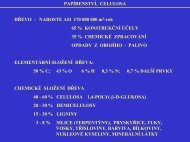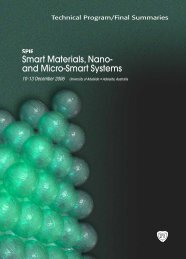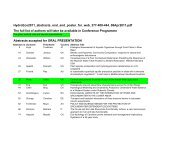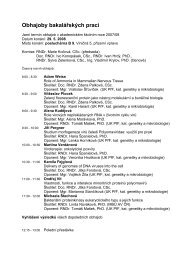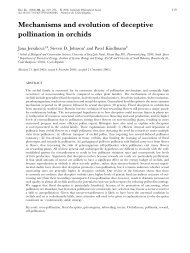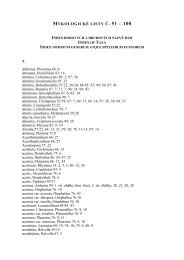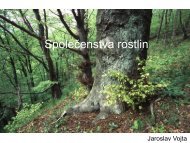Spatial distribution of phytoplankton in the eastern part of the North ...
Spatial distribution of phytoplankton in the eastern part of the North ...
Spatial distribution of phytoplankton in the eastern part of the North ...
- No tags were found...
You also want an ePaper? Increase the reach of your titles
YUMPU automatically turns print PDFs into web optimized ePapers that Google loves.
3.4. Differences <strong>in</strong> algal composition <strong>of</strong> bottom and surface water levelsAt four stations (every second station <strong>in</strong> <strong>the</strong> transect), <strong>the</strong> differences between bottom andsurface species composition were <strong>in</strong>vestigated. In this survey, a total <strong>of</strong> 70 species was foundaltoge<strong>the</strong>r at <strong>the</strong> four stations (46 diatoms, 17 d<strong>in</strong><strong>of</strong>lagellates, 7 species belong<strong>in</strong>g to o<strong>the</strong>r groups <strong>of</strong>algae). Most species exhibited <strong>the</strong> same abundance <strong>in</strong> both bottom and surface water samples,however several species, <strong>in</strong> <strong>the</strong> two largest groups <strong>of</strong> algae, showed a dist<strong>in</strong>ct vertical gradient. Therelative abundances <strong>of</strong> species, occurred <strong>in</strong> <strong>the</strong> bottom and surface water samples, are given <strong>in</strong> Tab. 8.Interest<strong>in</strong>gly, several diatoms were found to be more abundant <strong>in</strong> bottom water samples(Asterionellopsis glacialis, Pleurosigma lanceolatum, Neostrepto<strong>the</strong>ca sub<strong>in</strong>dica and Nitzschialongissima), while only Podosira stelliger was found more <strong>of</strong>ten <strong>in</strong> surface water samples. Theopposite pattern was found <strong>in</strong> two d<strong>in</strong><strong>of</strong>lagellate species (Ceratium l<strong>in</strong>eatum and Protoperid<strong>in</strong>iumachromaticum), which were more abundant <strong>in</strong> surface water samples. No d<strong>in</strong><strong>of</strong>lagellate speciesoccurred with higher abundance <strong>in</strong> bottom water samples.In Fig. 14, show<strong>in</strong>g <strong>the</strong> vertical gradient <strong>of</strong> diatom species abundance, <strong>the</strong> greatest differencebetween bottom and surface water species composition is apparent at station 153. There, <strong>the</strong> totalnumber <strong>of</strong> species occurr<strong>in</strong>g <strong>in</strong> surface or bottom water samples was 24 and 30, respectively. At <strong>the</strong>same station, <strong>the</strong> <strong>in</strong>verse vertical gradient <strong>of</strong> d<strong>in</strong><strong>of</strong>lagellate species was noted (Fig. 15). Due to <strong>the</strong>very small number <strong>of</strong> species found from o<strong>the</strong>r algal classes, vertical gradients were <strong>in</strong>terpretedonly for <strong>the</strong> two previously mentioned algal groups.Figure 14. Horizontal and vertical variation<strong>in</strong> <strong>the</strong> number <strong>of</strong> diatom species found. Redcolour <strong>in</strong>dicates <strong>the</strong> areas with <strong>the</strong> highestspecies richness.Figure 15. Horizontal and vertical variation<strong>in</strong> <strong>the</strong> number <strong>of</strong> d<strong>in</strong><strong>of</strong>lagellate speciesfound. Red colour <strong>in</strong>dicates <strong>the</strong> areas with<strong>the</strong> highest species richness.16




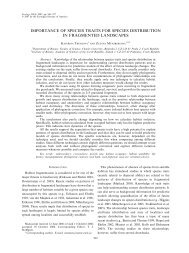
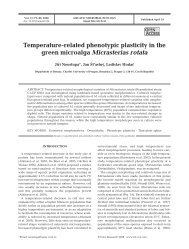
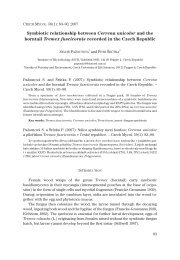
![[Cr(urea)6]Cl3](https://img.yumpu.com/47220263/1/184x260/crurea6cl3.jpg?quality=85)
